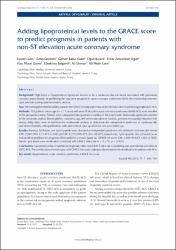| dc.contributor.author | Güler, Ekrem | |
| dc.contributor.author | Geçmen, Çetin | |
| dc.contributor.author | Güler Babür, Gamze | |
| dc.contributor.author | Karaca, Oğuz | |
| dc.contributor.author | Hicaz Zencirkiran, Agus | |
| dc.contributor.author | Güneş, Hacı Murat | |
| dc.contributor.author | Batgerel, Ulankhuu | |
| dc.contributor.author | Elveran, Ali | |
| dc.contributor.author | Esen, Ali Metin | |
| dc.date.accessioned | 10.07.201910:49:13 | |
| dc.date.accessioned | 2019-07-10T20:01:35Z | |
| dc.date.available | 10.07.201910:49:13 | |
| dc.date.available | 2019-07-10T20:01:35Z | |
| dc.date.issued | 2013 | en_US |
| dc.identifier.citation | Güler, E., Geçmen, Ç., Güler Babür, G., Karaca, O., Hicaz Zencirkiran, A., Güneş, Hacı M. ... Esen, A. M. (2013). Adding lipoprotein(a) levels to the GRACE score to predict prognosis in patients with non-ST elevation acute coronary syndrome. Kardiologia Polska, 71(7), 695-701. https://dx.doi.org/10.5603/KP.2013.0156 | en_US |
| dc.identifier.issn | 0022-9032 | |
| dc.identifier.uri | https://dx.doi.org/10.5603/KP.2013.0156 | |
| dc.identifier.uri | https://hdl.handle.net/20.500.12511/3356 | |
| dc.description | WOS: 000322659700006 | en_US |
| dc.description | PubMed ID: 23907902 | en_US |
| dc.description.abstract | Background: High levels of lipoprotein(a) [Lp(a)] are known to be a cardiovascular risk factor associated with premature coronary artery disease. In predicting the long term prognosis in acute coronary syndromes (ACS), the relationship between Lp(a) and risk scoring systems remains unclear. Aim: We investigated whether adding Lp(a) to the GRACE scoring system has an incremental value in predicting prognosis in ACS. Methods: 115 patients (mean age 64 +/- 11 years) with non-ST elevation acute coronary syndromes (NSTE-ACS) were enrolled in this prospective study. Patients were categorised into quartiles according to the Lp(a) levels. Statistically significant variables in the univariate analysis (haemoglobin, creatinine, age, left ventricular ejection fraction, previous myocardial infarction (MI) history, Killip class) were included in the multivariate analysis to determine the independent predictors of cardiovascular outcomes (mortality, rehospitalisation) with and without Lp(a) quartiles for one year follow-up. Results: Previous MI history and Lp(a) quartile were detected as independent predictors of combined cardiovascular events (OR: 2.969 [95% CI 1.413-6.240] and OR: 6.279 [95% CI 1.363-28.927] respectively). Lp(a) quartile also remained as an independent predictor for prognosis when added to a model based on GRACE risk score (OR: 2.589 [95% CI 1.402-4.780]). Serum Lp(a) levels were moderately correlated with GRACE risk score (r = 0.371; p < 0.001). Conclusions: Lipoprotein(a) has an additional prognostic value over GRACE risk score in predicting one-year adverse outcomes in NSTE-ACS. The combination of serum Lp(a) with GRACE risk score could provide enhanced risk stratification in patients with ACS. | en_US |
| dc.language.iso | eng | en_US |
| dc.publisher | Via Medica | en_US |
| dc.rights | info:eu-repo/semantics/openAccess | en_US |
| dc.subject | Lipoprotein(a) | en_US |
| dc.subject | Acute Coronary Syndromes | en_US |
| dc.subject | Grace Risk Score | en_US |
| dc.title | Adding lipoprotein(a) levels to the GRACE score to predict prognosis in patients with non-ST elevation acute coronary syndrome | en_US |
| dc.type | article | en_US |
| dc.relation.ispartof | Kardiologia Polska | en_US |
| dc.department | İstanbul Medipol Üniversitesi, Tıp Fakültesi, Dahili Tıp Bilimleri Bölümü, Kardiyoloji Ana Bilim Dalı | en_US |
| dc.authorid | 0000-0002-4607-5724 | en_US |
| dc.authorid | 0000-0002-4281-0867 | en_US |
| dc.identifier.volume | 71 | en_US |
| dc.identifier.issue | 7 | en_US |
| dc.identifier.startpage | 695 | en_US |
| dc.identifier.endpage | 701 | en_US |
| dc.relation.publicationcategory | Makale - Uluslararası Hakemli Dergi - Kurum Öğretim Elemanı | en_US |
| dc.identifier.doi | 10.5603/KP.2013.0156 | en_US |
| dc.identifier.wosquality | Q2 | en_US |
| dc.identifier.scopusquality | Q3 | en_US |


















